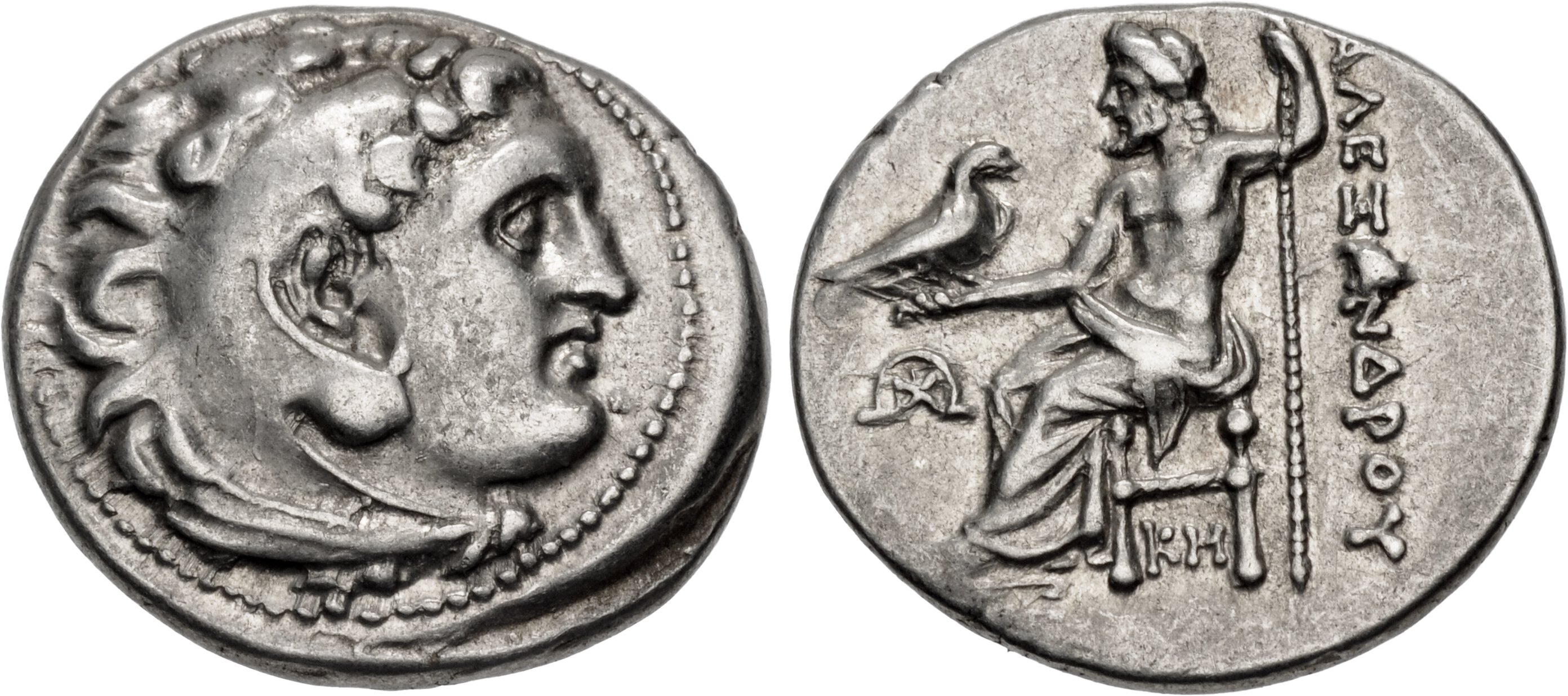Caunus (Alexander the Great), silver, drachms (Heracles/Zeus) (316-270 BCE)
From SILVER
316 BCE - 270 BCE Silver 769 kg
Description
| ObverseInscription or printing placed on the obverse.: | Head of Heracles right, wearing Nemean lion skin headdress. Border of dots. |
| ReverseInscription or printing placed on the reverse.: | AΛΕΞΑΝΔΡΟΥ (Greek).Zeus Aëtophoros seated left, monogram in left field, KH below throne |
Mint and issuing power
| MintIdentifies the place of manufacture or issue of a numismatic object.: | Caunus | Ancient regionAncient region.: | Caria | Modern countryModern country: Turkey | AuthorityIdentifies the issuing power. The authority can be "pretended" when the name or the portrait of X is on the coin but he/she was not the issuing power. It can also be "uncertain" when there is no mention of X on the coin but he/she was the issuing power according to the historical sources: | Alexander III the Great (Argead king, 336-323 BC) |
Chronology
| FromIdentifies the initial date in a range assigned in a numismatic context. | 316 BCE | toIdentifies the final date in a range assigned in a numismatic context.. | 270 BCE | PeriodTime period of the numismatic object.: Hellenistic 323-30 BC |
Physical description
| MetalThe physical material (usually metal) from which an object is made.: | Silver |
Median weightMedian of the weights of numismatic objects (in grams). in grams | 4.20 | DenominationTerm indicating the value of a numismatic object. Examples: tetradrachm, chalkous, denarius.: | drachma |
StandardStandard.: | Attic |
Image

H242 Mylasa drachms Alexander.jpg [1]
References
| Die study referencePublication of the study: | Thompson 19811Thompson 1981, Ashton 20042Ashton 2004 | ||
| Coin series referenceReference to coin series study: | RQEMH3RQEMH, n° 242, Price 19914Price 1991, n° 2479-2480 | ||
| Coin series web referenceCoin series web references: | |||
Obverse dies distribution
| FrequencyFrequency of specimen in distribution. ᵖ | Number of obversesNumber of obverse dies. ᵖ (o) | % (o) | Number of coinsNumber of coins. (n) | % (n) | Die nameName(s) of the die(s). |
| 1 | 1 | 16.67 | 1 | 7.69 | 1 |
| 2 | 3 | 50 | 6 | 46.15 | 2, 4, 9 |
| 3 | 2 | 33.33 | 6 | 46.15 | 6, 16 |
| Total | 6 of 6 | 100 | 13 of 13 | 99.99 |
Reverse dies distribution
no distribution is available
Quantification
| Number of obversesNumber of obverse dies. ᵖ (o) | 6 | Number of singletons (o1)The number of singleton coins. ᵖ | 1 |
| Number of reverse diesNumber of reverse dies. (r) | 13 | Number of coinsNumber of coins. (n) | 13 |
| Coins per obverse dieNumber of coins per obverse die. (n/o) | 2.17 | Coins per reverse dieNumber of coins per reverse die. (n/r) | 1 |
| Reverse per obverse ratioRatio of obverse dies divided by reverse dies. (r/o) | 2.17 | Percentage of singletons (o1)number of coins (n) divided by the number of singletons (o1) ᵖ | 16.67 % |
| Original number of dies (O) (Carter 1983 formula)The estimation of the number of coins according to Carter 1983 ᵖ | 9.16 | Coins struck if 20,000 as average productivity per dieCoins made if the average productivity for obverses (according to Carter) is 20,000. ᵖ | 183,200 |
| Original number of dies (O) (Esty 2011 formula)The estimation of the number of coins according to the singleton formula in Esty 2011 ᵖ (O) | 11.14 | Survival rate if 20,000 as average productivity per dieSurvival rate if average productivity is 20,000. ᵖ | 0.00007 |
| Coverage (o = % of O) (Esty 1984 formula)Esty 1984 - coverage (% of O) ᵖ (o = % of O) | 92.31% | Die productivity if survival rate 1/2,000Average productivity if survival rate is 1/2,000. ᵖ | 2,838.43 |
| Weight of silver (in kg) if 20,000 coins per die (O = Carter formula)Carter 1983 * Median weight * 20000 (*10 if gold or electrum) ᵖ | 769 kg <br /> 769 kg | Die productivity if survival rate 1/5,000Average productivity if survival rate is 1/5,000. ᵖ | 7,096.07 |
Remarks
Most likely one single workstation Likely military Located in Mylasa, this coinage has been subsequently attributed by Ashton to Caunus
References
- ^ Thompson, Margaret (1980), "The Alexandrine Mint of Mylasa", Numismatica e Antichità Classiche, 10, p. 207-217, pl. 1.
- ^ Ashton, Richard (2004), "Kaunos, not Miletos or Mylasa," The Numismatic Chronicle, 64, p. 33-46, pl. 2
- ^ Callataÿ, François de (1997), Recueil quantitatif des émissions monétaires hellénistiques, Numismatique Romaine, Wetteren, X + 341 p.
- ^ Price, Martin Jessop (1991), The Coinage in the Name of Alexander the Great and Philip Arrhidaeus: a British Museum Catalogue, 2 vol., Zürich-London, 637 p., 637 p., clix pl.